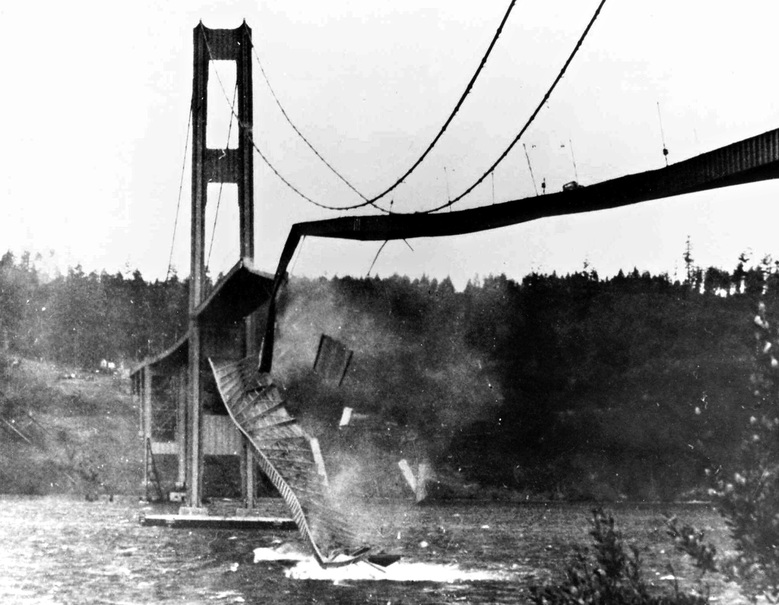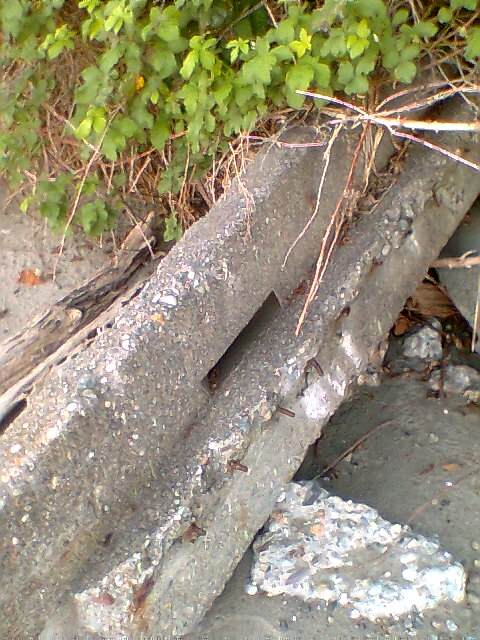Tacoma Narrows Bridge (Galloping Gertie)
This website covers the history of all three suspension bridges that are currently in or were in service over the Narrows that are (or were) a part of what is now known at Washington State Route 16 connecting Interstate 5 to Bremerton.
This website identifies them by the following names:
Galloping Gertie-Opened July 4, 1940. Collapsed November 7, 1940. It was built as a WPA project to provide transportation needs for military services between Bremerton and McCord (which opened the same time the bridge did).
Sturdy Gertie-Opened September 1950. Built in the existing location of where Galloping Gertie stood and uses the same anchors and caissons as well as towers 1-3 on the peninsula side of the bridge. This bridge handles traffic from Tacoma into Gig Harbor.
Greedy Gertie-Opened July 2007. Built south of Sturdy Gertie and provides service from Gig Harbor to Tacoma. This span provide pedestrian traffic as well. The nickname is given for the expensive tolls collected.

(source: James Bashford (creative commons licensing))
Living in the Puget Sound area for a majority of my life, exploring, photographing, and documenting many parts of the Puget Sound for several years has been a fun hobby, but most of the time, this section of Puget Sound was recorded the most.
To find a major suspension bridge being constructed in the 21st century in America is rare. A major suspension bridge hasn't been constructed since 1964 in the United States. While many major suspension bridges have been built in other parts of the world for the past several years, the lessons about the application and their design happened right here as American was getting involved in World War 2.
The first Tacoma Narrows Bridge was constructed in 1939 and went into service on July of 1940. When constructed, it was the third largest suspension bridge in the world. Only the Golden Gate and the George Washington Bridge were larger.
Unlike the suspension bridges built in San Francisco, this bridge was built on a very low budget using cheap beams and girders to create a two lane bridge that looked like ribbon and moved freely in the wind.
Engineers didn't see a reason to test bridges in a wind tunnel. After the bouncing of the roadbed was reported to the engineer (Leon Moiseiff) he did indicate that the Bronx Whitestone Bridge and the Deer Island Bridge were doing the same thing, it became the responsibility of the state to find out why it was happening and how to prevent it.
University of Washington Engineering Professor Farquarson made a scale model of the bridge to test the affects of wind using a wind tunnel. To solve the bouncing, it was decided to add additional cables below the bridge and secure them using concrete block or cables connected to the towers. While this helped in 50 mph winds, early November was a stormy time of the year and eventually the cables broke (many bridges today use additional cable supports above the roadbed rather than below).
It was during this time that Professor Farquarson would present his findings to the State of Washington. His suggestions were to either drill holes in the side beams or using fairings on the outer sides of the bridge to deflect the wind. The state was interested in the fairlings (they didn't want to drill holes in the bridge) and could have had the work completed within 40 days but it was too late.
The center span of the bridge fell on November 7th 1940 at wind speeds that had gusts from 38-42 mph after the bridge twisted from side to side for about 30 minutes.
The video produced by Barney Elliot shows the roadbed movement while a vehicle (left on the roadway) was left behind by Tacoma News Tribune reporter Leonard Coatsworth. Farquarson and others tried to get the dog, Tubby from the vehicle but the dog didn't want to get out of the vehicle biting those that tried.
What caused the bridge to fail?
Because the bridge didn't have anywhere for the wind to travel through the bridge, the solid girders on the the sides of the bridge pushed it causing the twisting of the center span of the roadbed (in the same way you push a child on swing at the park).
The bouncing movement could have been prevented if venting were added to the roadbed.
When Sturdy Gertie was built, grated surfaces were added to the roadbed as well as railings that were opened for airflow.
The current bridges has steel girders added below the roadbed to stiffen the bridge as well. After Galloping Gertie broke, bridges that didn't have these girders below the roadbed were added above the roadbed instead.
While these girders did help save the bridges from twisting or moving, the additional weight to the roadbed added weight restrictions so that semi truck couldn't use them. Eventually these roadbeds were replaced with the fairlings added to the sides of the bridge.
The math behind what happened
In th 1970's IBM had an exhibit at the Pacific Science Center (known as Mathematica) that brought up the fact that no one was able to come up with a mathematical equation at to what happened.
Some of the reasons for this was due to the fact that that many concluded the bridge failure was due to resonance, which collapsed at the result of the harmonics (oscillation frequency) being greater than the bridge itself. The problem with this answer is the wind velocity varies (as demonstrated after the collapse when smoke testing was done).
Around the time of the 50th anniversary of the collapse, Princeton University engineers came up with better conclusion (and the math) that concluded that vortex shredding was responsible for the failure of the bridge.
The Wikipedia page goes into detail about this subject which is still up for debate in college classrooms even today.
Tacoma Narrows Today
It seems insane that anyone would design a two lane suspension bridge with the amount of traffic between Gig Harbor and Tacoma that uses this crossing on a daily basis. Thankfully, the second Tacoma Narrow Bridge (Sturdy Gertie) was completed in 1950 using the same supports the Galloping Gertie was built on and continues to handle traffic from Tacoma to the Olympic Peninsula to this day.
When the 50th Anniversary of Galloping Gertie was going on, The Tacoma News Tribune was reporting on either expanding the existing bridge to handle more lanes of traffic or build another bridge. The latter was chosen.
In July of 2007 the third Tacoma Narrows Bridge (now known as Greedy Gertie due to the tolls) took 6 years to construct due to safety and environmental concerns.
There are photos taken from the construction of the concrete towers, to the spinning of the suspension cables, to the assembly of the roadbed.
While taking these photos, the remains of Galloping Gertie were found on the shore (Narrows Park on the Peninsula side) were they have stayed since they were jackhammered into the sound and it's shores below.

(Galloping Gertie remains on the shore (source: Tim Babcock))
The photo above is used for the Wikipedia page on the bridge while a digital video was shot of the remains for a You Tube to show it's construction.
The remains of Galloping Gertie rest in the Puget Sound and are protected as a historical monument (Historical Monument 92001068). The section of roadway that is at the Washington State Historical Museum in Tacoma was a section that was removed (near the location in the photo above). When the third bridge was built during the construction of the caissons.
Just before relocating to Oregon, the first year of the third bridge was spent taking photos in the area as it was easy to walk to from living on 6th Ave and Jackson in Tacoma. While the approaches to the third bridge were noisy, they have found some ways to baffle the sound.
Many bridges that were built with the design that Moiseiff created, have fairlings on the sides of the girders. Not only were these added to the Bronx-Whitestone and Deer Island Bridges in the 21st century, but the Lionsgate Bridge uses fair lings as well as the alternative to adding additional girders to stiffen the roadbed was affecting the lifespan of the roadbed (due to the weight) and had to be replaced.
If Galloping Gertie survived as a bridge
If Galloping Gertie was spanning the Puget Sound today, it would have been inadequate for cars and trucks to travel.
The post World World 2 economy would have made this bridge obsolete (if it wasn't destroyed from the 1949 earthquake).
With needed modifications to the bridge, it's two lane design would have resulted in traffic tie ups and accidents. It's flimsy design would have made it impossible for semi trucks and busses to use due to their weight.
If it were standing today, it would only be good for pedestrians and bicycles to use and probably would have taken it's place in history as one of the most expensive (and perhaps largest) pedestrian bridges in the world.